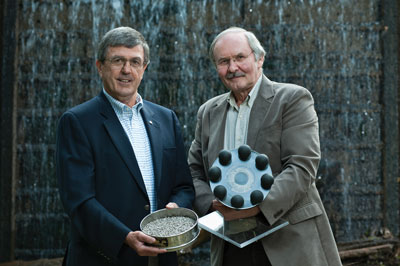
Features
Structures & Equipment
Water and irrigation
Wastewater resources
January 28, 2011 By Dave Harrison (with files from UBC and NSERC)
Sustainability is a growing issue with consumers, and the work by a
Canadian researcher offers an ideal solution of having a major waste
treatment problem turned into an effective plant growth resource.
Sustainability is a growing issue with consumers, and the work by a Canadian researcher offers an ideal solution of having a major waste treatment problem turned into an effective plant growth resource.
 |
|
| Dr. Donald Mavinic (left) and research associate Frederich Koch with a container of crystallized struvite. Advertisement
|
University of British Columbia researcher Don Mavinic and industry partners have been recognized with a prestigious award from Canada’s leading science and engineering funding agency for developing a technology that transforms wastewater nutrients into valuable fertilizer.
The UBC civil engineering professor has received a 2010 Synergy Award for Innovation of $200,000 from the Natural Sciences and Engineering Research Council of Canada (NSERC) as a result of his collaboration with Ostara Nutrient Recovery Technologies Inc., Stantec Consulting Ltd., Metro Vancouver, EPCOR Water Service Inc. and Clean Water Services Ltd.
“PERSEVERANCE AND PATIENCE SHOWN BY OUR PARTNERS HAVE BEEN REWARDED”
■ “I am both honoured and pleased to receive the Synergy Award from NSERC, not only for myself, but also for my UBC-based research team and our talented industry partners,” says Mavinic, an expert in wastewater treatment. “The perseverance and patience shown by our partners have been rewarded, and for this, we are all very grateful.”
 |
|
| A clogged section of sewer pipe. PHOTOS BY MARTIN DEE
|
John Hepburn, UBC vice-president Research and International, says the award “is a major accomplishment for any Canadian researcher in the natural and applied sciences, and Prof. Mavinic certainly deserves recognition for his hard work and ingenuity.” The school, he adds, “has strongly supported his efforts to make this exciting technology available and we believe it will have significant environmental and economic benefits.”
Mavinic is a co-inventor of the nutrient recovery technology commercialized by UBC spin-off company Ostara Nutrient Recovery Technologies. Ostara’s Pearl® Nutrient Recovery Technology recovers otherwise polluting nutrients such as phosphorus and ammonia from wastewater and transforms them into an environmentally friendly fertilizer called Crystal Green®.
“I have been researching different wastewater technologies for over 35 years,” Mavinic explains,” and have been researching nutrient removal and biosolids management for the last 25 years.”
EYEING POTENTIAL OF A FERTILIZER HELPED DRIVE WASTE STREAM STUDY
■ It’s only been since 2000 that he’s been researching nutrient recovery from treated waste streams. “We realized that there was a fertilizer end product at stake if we did it right.”
The environmental benefits of the technology are enormous. Both ammonia and phosphorus in treated domestic and animal waste streams are major problems, including ammonia toxicity to fish in receiving waters. “These two nutrients, if not controlled, cause serious pollution problems, including excess algae and weed growth, such as what we’ve seen in lakes Erie and Winnipeg, as well as Chesapeake Bay,” says Mavinic.
A single Pearl reactor can produce more than 500 kilograms of high-quality fertilizer, known as Crystal Green per day, while saving wastewater treatment plants hundreds of thousands of dollars a year in cleanup costs to get mineral buildup out of pipes and equipment.
Ostara is currently operating three U.S. commercial Nutrient Recovery Facilities in Tigard, near Portland, Oregon; Suffolk, Virginia (on Chesapeake Bay); and York, Pennsylvania. It is also constructing facilities in Madison, Wisconsin, and London, U.K. Earlier this year, Ostara was named a 2011 Technology Pioneer by the World Economic Forum and a Top 100 Global CleanTech Companies by The Guardian, a London-based media group.
EXCELLENT SLOW RELEASE CHARACTERISTICS IN PRODUCT
■ The fertilizer is well received in the market. “Crystal Green is one, super fertilizer, with excellent slow release characteristics,” says Mavinic. “Plants and turf love it. It’s unique in the marketplace, because it has a great combination of phosphorus and magnesium, both of which are essential, and plant roots take them up in the same ratio, as needed. There is no waste or runoff. I just wish we had more full-scale reactors operating right now.”
The NSERC Synergy Awards for Innovation, launched in 1995, recognize partnerships between universities and industry that foster economic growth and improve the lives of Canadians. In addition to research funding for the honourees, the industry partners receive support to hire an NSERC Industrial R&D Fellow for a two-year term.
“The strategic investments that NSERC has made over the years have led to numerous successful collaborations such as the one we are recognizing here,” says NSERC president Suzanne Fortier. “The Synergy Awards highlight partnerships that bring together the best researchers from Canadian universities and the leading innovators from the private sector, resulting in the transfer of tangible research results to those who can translate them into economic and social benefits for Canadians.”
TECHNOLOGY SEEN AS A WIN-WIN PROPOSITION
■ In a posting on its website, NSERC notes that “the technology is proving to be a win-win proposition. Through fertilizer sales, the nutrient recovery system pays for itself in five to seven years. In addition, removing phosphorus helps the sewage treatment plant run more smoothly. Phosphorus forms crystals known as struvite that build up on the inner walls of sewage plant pipes and must be removed regularly to avoid blockage.”
The NSERC award follows another national honour for Mavinic, who received the Ernest C. Manning Awards Foundation’s Dave Mitchell Award of Distinction last September.
NSERC is a federal agency that helps make Canada a country of discoverers and innovators for the benefit of all Canadians. The agency supports some 29,500 university students and postdoctoral fellows in their advanced studies. It provides funding to more than 11,800 university professors every year and fosters innovation by encouraging more than 1,500 Canadian companies to participate and invest in post-secondary research projects.
Print this page